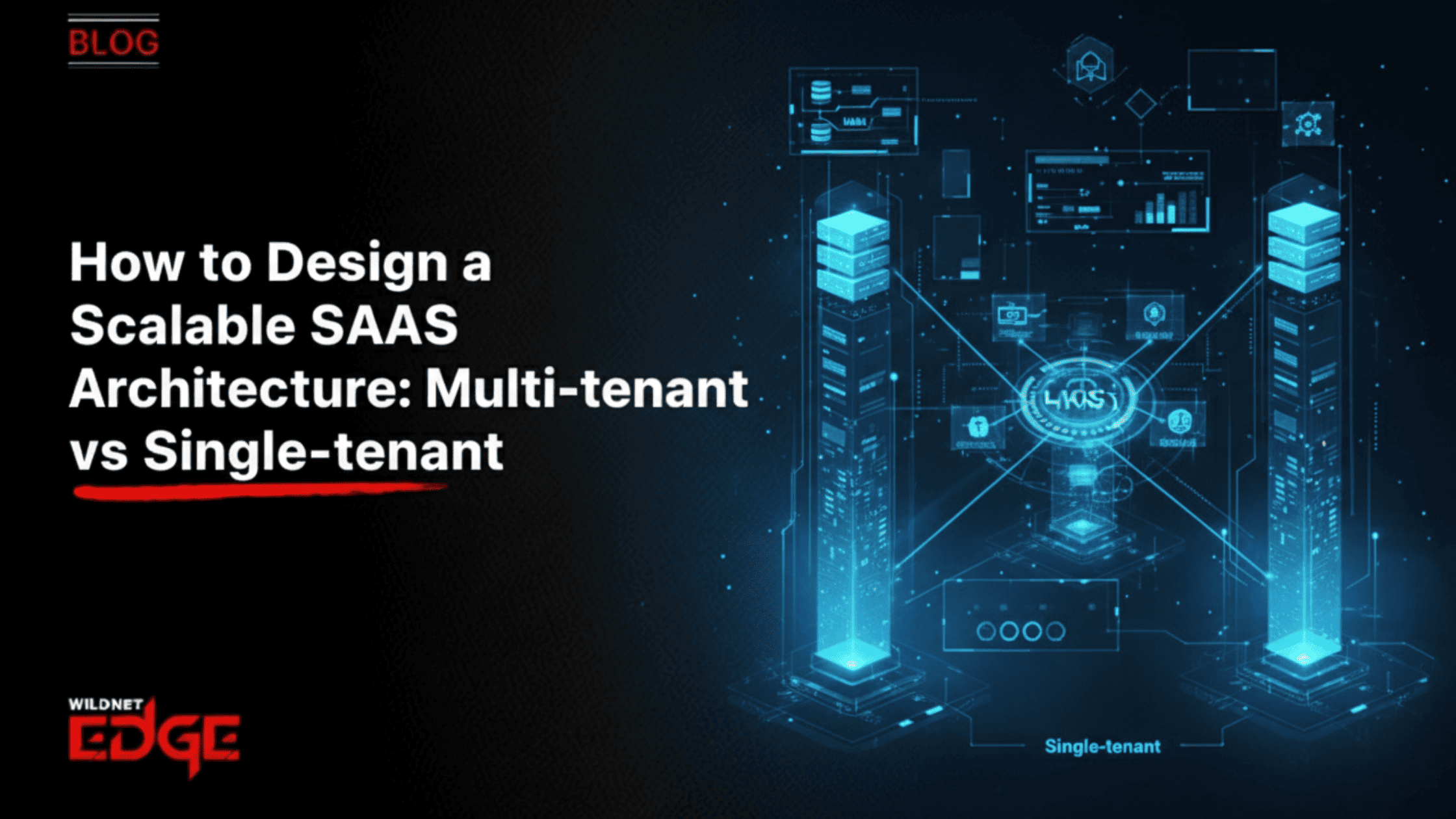TL;DR
The article explores how to design scalable SaaS architecture, focusing on the key choice between multi-tenant and single-tenant models. It explains how this decision affects cost, scalability, security, and customization. Multi-tenancy offers cost efficiency through shared resources, while single-tenancy delivers higher security and flexibility at greater expense. The piece also covers cloud-native design, database strategy, and microservices, helping businesses choose the right model based on their market, goals, and compliance needs.
Building a successful Software-as-a-Service (SaaS) application requires more than just innovative features; it demands a robust, scalable, and cost-effective foundation. The architectural decisions made early in the development process have long-lasting implications for your ability to grow, adapt, and remain competitive. One of the most fundamental choices in SaaS architecture design is selecting between a multi-tenant and a single-tenant model. Understanding the tradeoffs is critical for building a platform that aligns with your business goals.
What is SaaS Architecture?
SaaS architecture refers to the underlying structure and design principles used to build, deploy, and manage a cloud-based software application delivered on a subscription basis. It encompasses everything from the database design and backend logic to the infrastructure deployment and scaling strategy. A well-designed architecture ensures the application is reliable, performant, secure, and capable of handling a growing number of users efficiently. This often involves leveraging expert SaaS platform architecture consulting.
The Core Decision: Multi-Tenant vs. Single-Tenant
This is the most critical architectural choice with significant implications for cost, complexity, and customer experience.
Multi-Tenant SaaS Architecture
- Concept: A single instance of the software application and its supporting infrastructure serves multiple customers (tenants). Each tenant’s data is logically isolated within a shared database or separate schemas, but they run on the same application code and infrastructure.
- Analogy: Think of an apartment building. All tenants share the same building structure, foundation, and utilities, but each has their own private, locked apartment unit.
- Pros:
- Cost Efficiency: Significantly lower infrastructure and maintenance costs per customer due to shared resources.
- Easier Updates: Updates and patches are applied once to the central instance, benefiting all tenants simultaneously.
- Faster Onboarding: Provisioning a new tenant is typically quick and automated.
- Cons:
- Complexity: Requires sophisticated design to ensure strict data isolation and security between tenants.
- “Noisy Neighbor” Problem: A resource-heavy tenant could potentially impact the performance for others (though good design mitigates this).
- Limited Customization: Customizing the core application for a single tenant is often difficult or impossible.
Single-Tenant SaaS Architecture
- Concept: Each customer (tenant) gets their own dedicated instance of the software application and supporting infrastructure (database, servers). Their environment is physically isolated from all other tenants.
- Analogy: Think of single-family homes in a neighborhood. Each resident has their own separate house, foundation, and utilities.
- Pros:
- Maximum Security & Isolation: Provides the highest level of data security as tenant data is physically separate.
- High Customization Potential: Easier to customize the application or infrastructure for a specific tenant’s needs.
- Guaranteed Performance: Eliminates the “noisy neighbor” problem as resources are dedicated.
- Cons:
- Higher Cost: Significantly higher infrastructure and maintenance costs per customer due to dedicated resources.
- Complex Updates: Updates must be rolled out individually to each tenant’s instance.
- Slower Onboarding: Provisioning a new, dedicated instance takes more time and effort.
Choosing the Right Model for Your Business
Your target market and business plan largely determines the “best” method.
- Multi-Tenancy: Generally regarded as the best model for the scalable and multi-tenant SaaS, primarily targeting small to medium-sized businesses (SMBs) or applications where standardization is crucial. The resulting cost efficiencies make it possible to offer more competitive prices.
- Single-Tenancy: Generally being the main choice of the backend architecture for SaaS services for enterprises, especially in sectors with high regulation (such as finance or healthcare) when companies have very strict requirements regarding security, compliance or customization. The extra cost is backed up by the superior security and control given to the customers.
- Hybrid Approach: Some platforms provide a hybrid approach, so to speak, where multi-tenancy is applied to smaller tiers while dedicated single-tenant instances are provided to large enterprise clients.
Key Architectural Considerations for Scalability
Regardless of the tenancy model, building a scalable SaaS architecture involves several best practices.
- Cloud-Native Design: Leverage cloud provider services (AWS, Azure, GCP) for elasticity. Use auto-scaling, load balancing, and managed services (databases, message queues) designed for scale. This is central to a modern cloud-native SaaS design. Utilizing expert cloud scaling and orchestration services is crucial here.
- Microservices Architecture: Decompose the application into smaller, independent services. This allows you to scale specific components (like login services or reporting services) independently based on load, which is more efficient than scaling a monolith.
- Stateless Application Tier: Design your application servers to be stateless, meaning session data is stored centrally (e.g., in Redis or a database). This allows any server instance to handle any user request, facilitating horizontal scaling.
- Database Scalability Strategy: Plan your database scaling approach early (e.g., read replicas, sharding, choosing appropriate NoSQL databases for specific needs). The database is often the biggest bottleneck in SaaS backend architecture enterprise applications.
SaaS Architecture in Action: Case Studies
Case Study 1: A Multi-Tenant Platform for SMBs
- The Challenge: A startup was building a project management tool targeted at small creative agencies. Cost-efficiency and rapid onboarding were critical for their business model.
- Our Solution: We designed and built a scalable multi-tenant SaaS architecture on AWS. We used a shared database with strict row-level security to ensure data isolation and implemented automated tenant provisioning scripts.
- The Result: The platform launched with a competitive price point due to the cost efficiencies of multi-tenancy. They were able to onboard hundreds of new clients quickly and automatically, and the shared infrastructure kept their operational costs low as they scaled.
Case Study 2: A Single-Tenant Solution for Financial Institutions
- The Challenge: A FinTech company was developing a compliance reporting platform for large banks. Each bank had extremely strict data residency and security requirements, mandating complete data isolation.
- Our Solution: We architected a single-tenant solution deployed within isolated virtual private clouds (VPCs) for each client on Azure. While this increased infrastructure complexity, it provided the absolute data segregation and customization potential required by their enterprise clients. This required complex custom enterprise platform modernization.
- The Result: The single-tenant architecture allowed the company to meet the stringent security and compliance demands of the banking sector. This became a key differentiator, enabling them to win major enterprise deals despite the higher price point.
Our Technology Stack for SaaS Architecture
We leverage modern, cloud-native technologies.
- Cloud Platforms: AWS, Azure, Google Cloud
- Containerization & Orchestration: Docker, Kubernetes
- Backend: Node.js, Python, .NET, Go
- Databases: PostgreSQL (with extensions like Citus), MySQL, MongoDB Atlas, Cosmos DB, DynamoDB
- Infrastructure as Code: Terraform, Pulumi
- API Gateways: AWS API Gateway, Azure API Management
Conclusion
Designing the right SaaS architecture is a foundational strategic decision with long-term consequences. The choice between multi-tenant and single-tenant models directly impacts your cost structure, scalability potential, and ability to serve specific market segments. By carefully considering your business goals, target audience, and leveraging cloud-native SaaS design principles, you can build a platform that is not only functional but also resilient, efficient, and ready for growth.
Ready to architect a SaaS platform for market leadership? At Wildnet Edge, our AI-first approach ensures we build intelligent, data-driven applications. We specialize in creating scalable, secure, and integration-ready enterprise apps, providing the expert guidance needed to make the right architectural choices for your success.
FAQs
Single-tenant offers the highest level of security due to complete physical or virtual isolation. Multi-tenant requires meticulous application-level and database-level security design to ensure one tenant cannot access another’s data. Both can be highly secure if implemented correctly, but multi-tenancy requires more complex security engineering.
Migrating existing tenants from a shared multi-tenant database to individual single-tenant instances can be extremely complex and risky. It’s much easier to design for single-tenancy from the start or offer it as a premium option for new, large clients alongside a multi-tenant base offering.
Single-tenant architectures make deep customization much easier, as changes only affect one client’s dedicated instance. Customizing a core multi-tenant application for a single client is often impractical or requires complex feature flagging and configuration management.
Microservices can be used with either model. In a multi-tenant system, shared microservices handle requests from multiple tenants (requiring tenant context awareness). In a single-tenant system, each tenant might get their own set of microservice instances, or some core services might still be shared while tenant-specific data services are isolated.
Common strategies include:
* Shared Database, Shared Schema: Simplest, but requires strict row-level security based on a tenant_id.
* Shared Database, Separate Schemas: Each tenant gets their own schema within a single database instance. Offers better isolation but can be harder to manage migrations across many schemas.
* Separate Databases: Each tenant gets their own database instance. Offers best isolation but higher cost (approaching single-tenant).
This requires careful monitoring and potentially implementing throttling or rate-limiting mechanisms at the application or infrastructure level. Designing stateless services and using horizontally scalable components (like serverless functions or containerized services) helps mitigate the “noisy neighbor” effect.
The first step is a deep requirements analysis and architectural design session. Before choosing specific technologies or tenancy models, you must clearly define your target market’s needs, your business model, your scalability projections, and your security/compliance requirements.

Nitin Agarwal is a veteran in custom software development. He is fascinated by how software can turn ideas into real-world solutions. With extensive experience designing scalable and efficient systems, he focuses on creating software that delivers tangible results. Nitin enjoys exploring emerging technologies, taking on challenging projects, and mentoring teams to bring ideas to life. He believes that good software is not just about code; it’s about understanding problems and creating value for users. For him, great software combines thoughtful design, clever engineering, and a clear understanding of the problems it’s meant to solve.
 sales@wildnetedge.com
sales@wildnetedge.com +1 (212) 901 8616
+1 (212) 901 8616 +1 (437) 225-7733
+1 (437) 225-7733































